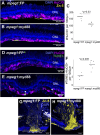Forced MyD88 signaling in microglia impacts the production and survival of regenerated retinal neurons
- PMID: 39633708
- PMCID: PMC11614808
- DOI: 10.3389/fcell.2024.1495586
Forced MyD88 signaling in microglia impacts the production and survival of regenerated retinal neurons
Abstract
Inflammation and microglia appear to be key factors influencing the outcome of retinal regeneration following acute retinal damage. Despite such findings, direct connection of microglia-specific inflammatory factors as drivers of regenerative responses in the retina are still not defined, and intracellular pathways activated to stimulate such signals from microglia are currently unknown. We became interested in MyD88 regulation in microglia because transcriptomic datasets suggest myd88 could be regulated temporally in zebrafish microglia responding to damage in the central nervous system. MyD88 is an intracellular molecular adaptor that initiates signaling cascades downstream of several innate immune receptors, and probably most well-known for inducing gene expression of pro-inflammatory factors. Using zebrafish, which spontaneously regenerate retinal neurons after acute retinal damage, we studied the effects of overactivation of MyD88 signaling in microglia and macrophages on the Müller glia-mediated regenerative response. Our results indicate that increased MyD88 signaling in microglia/macrophages impacts the initial response of Müller glia entering a regenerative response after acute, neurotoxin-induced retinal damage to inner retinal neurons. In addition, increased MyD88 signaling in microglia/macrophages resulted in reduced survival of inner retinal neurons in regenerated retinas. This work supports the idea that temporal control of inflammatory signaling is a key component in the production of MG-derived progenitors yet further indicates that such control is important for differentiation and survival of regenerated neurons.
Keywords: MyD88; Müller glia; NFkB; inflammation; microglia; regeneration; retina; zebrafish.
Copyright © 2024 Rumford, Grieshaber, Lewiston, Reed, Long and Mitchell.
Conflict of interest statement
The authors declare that the research was conducted in the absence of any commercial or financial relationships that could be construed as a potential conflict of interest.
Figures








Similar articles
-
Dynamic changes in microglial and macrophage characteristics during degeneration and regeneration of the zebrafish retina.J Neuroinflammation. 2018 May 28;15(1):163. doi: 10.1186/s12974-018-1185-6. J Neuroinflammation. 2018. PMID: 29804544 Free PMC article.
-
Patterns of NFkB activation resulting from damage, reactive microglia, cytokines, and growth factors in the mouse retina.Exp Neurol. 2023 Jan;359:114233. doi: 10.1016/j.expneurol.2022.114233. Epub 2022 Sep 27. Exp Neurol. 2023. PMID: 36174748 Free PMC article.
-
Photoreceptor regeneration occurs normally in microglia-deficient irf8 mutant zebrafish following acute retinal damage.Sci Rep. 2024 Aug 30;14(1):20146. doi: 10.1038/s41598-024-70859-9. Sci Rep. 2024. PMID: 39209978 Free PMC article.
-
Inflammation Regulates the Multi-Step Process of Retinal Regeneration in Zebrafish.Cells. 2021 Apr 1;10(4):783. doi: 10.3390/cells10040783. Cells. 2021. PMID: 33916186 Free PMC article. Review.
-
Retinal regeneration requires dynamic Notch signaling.Neural Regen Res. 2022 Jun;17(6):1199-1209. doi: 10.4103/1673-5374.327326. Neural Regen Res. 2022. PMID: 34782554 Free PMC article. Review.
Cited by
-
Single-cell transcriptome of retinal myeloid cells in response to transplantation of human neurons reveals reversibility of microglial activation.bioRxiv [Preprint]. 2025 May 21:2025.05.16.654622. doi: 10.1101/2025.05.16.654622. bioRxiv. 2025. PMID: 40475635 Free PMC article. Preprint.
References
Grants and funding
LinkOut - more resources
Full Text Sources

